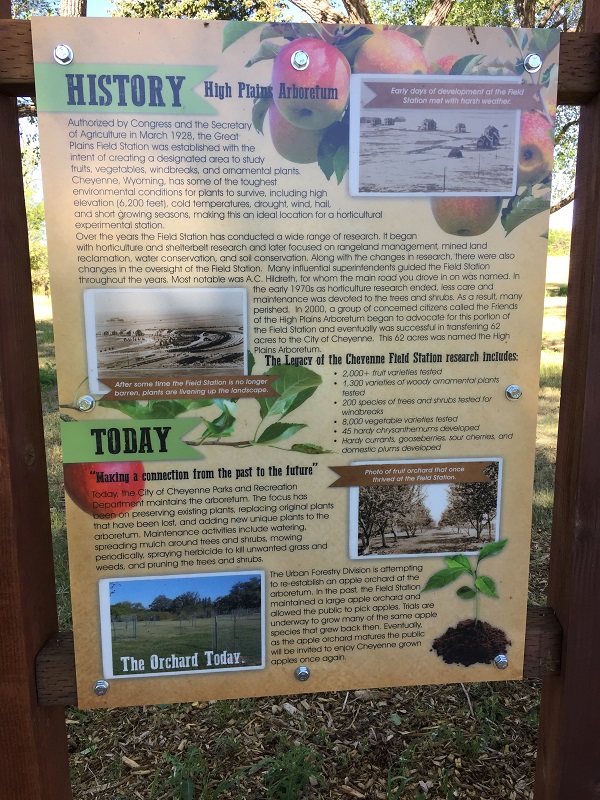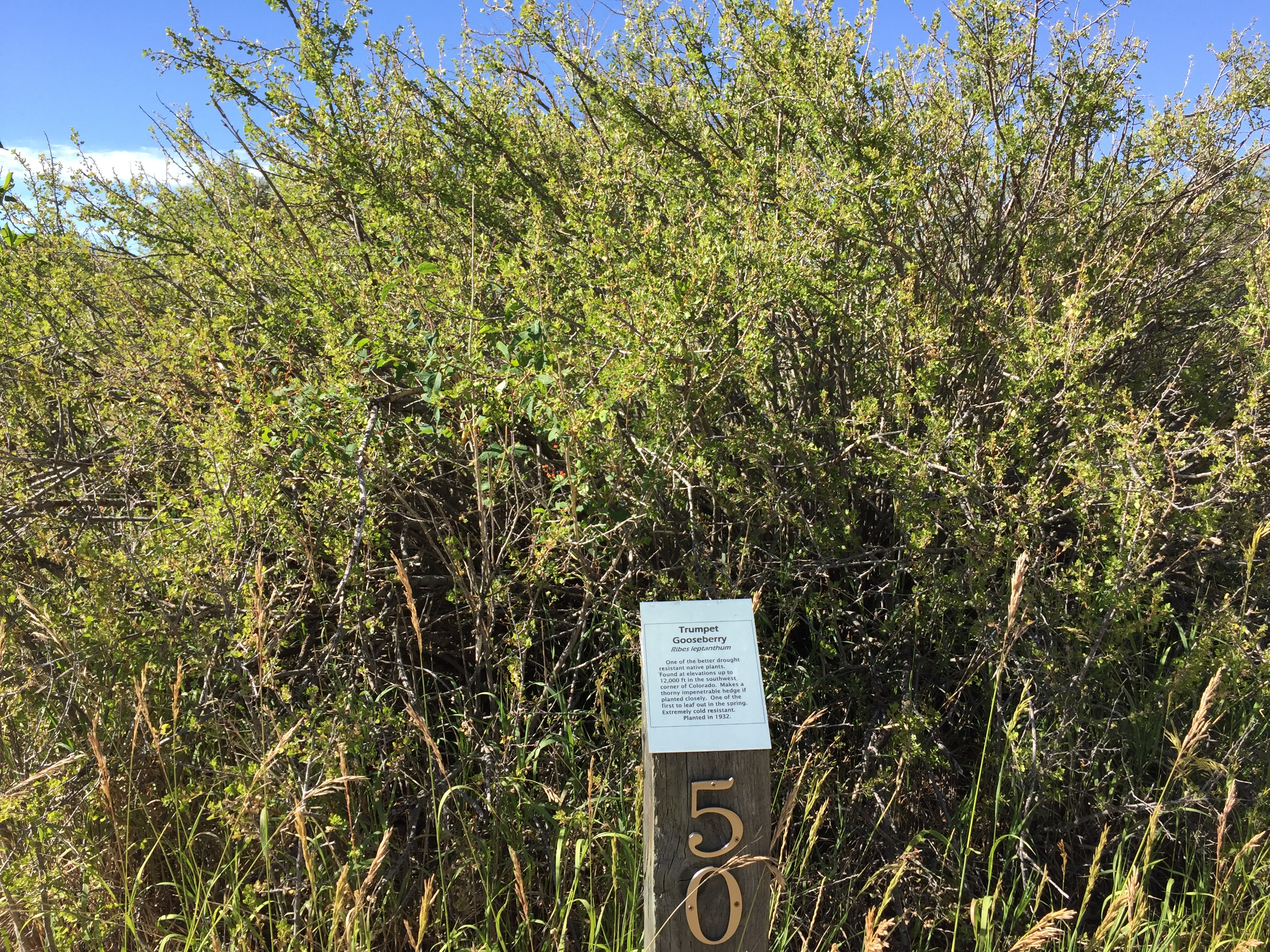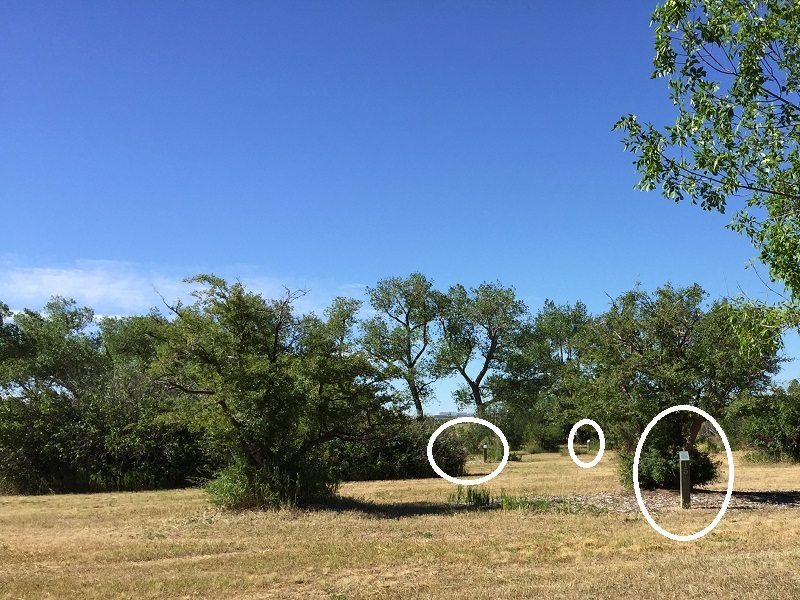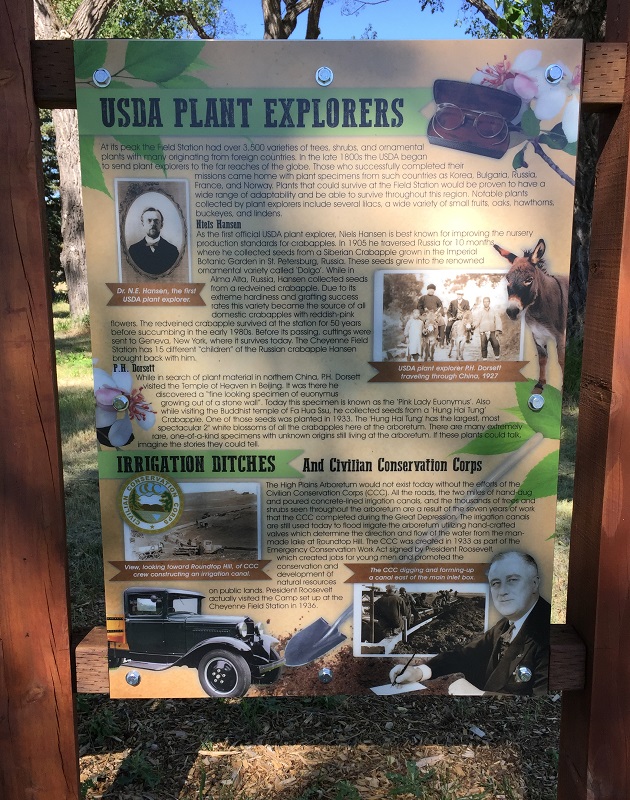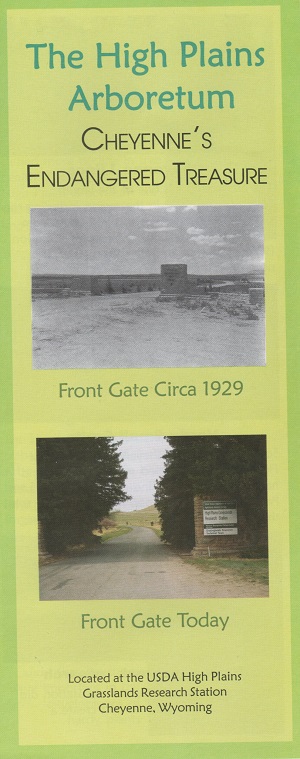Cheyenne’s High Plains Arboretum is a little known gem. It is associated with the Cheyenne Botanic Gardens, but instead of growing colorful flowers, they concentrate on trees and shrubs. (http://www.botanic.org/discover/high-plains-arboretum/)

The High Plains Arboretum consists of 62 acres of historical trees and shrubs, many of which were brought to this country by “plant hunters” employed by the USDA. The idea was to see which trees could be successfully introduced to the United States. Given Wyoming’s brutal climate it was thought that trees that could succeed here could succeed anywhere in the US!
The High Plains Arboretum is still being developed for tourists. There’s no official parking, for example. There’s a clearing just beyond the sign pointing to the Arboretum’s “entrance” – a wooden bridge over a narrow concrete irrigation channel, on the right. There’s precious little grass here and it is the only place where one can park off the road.
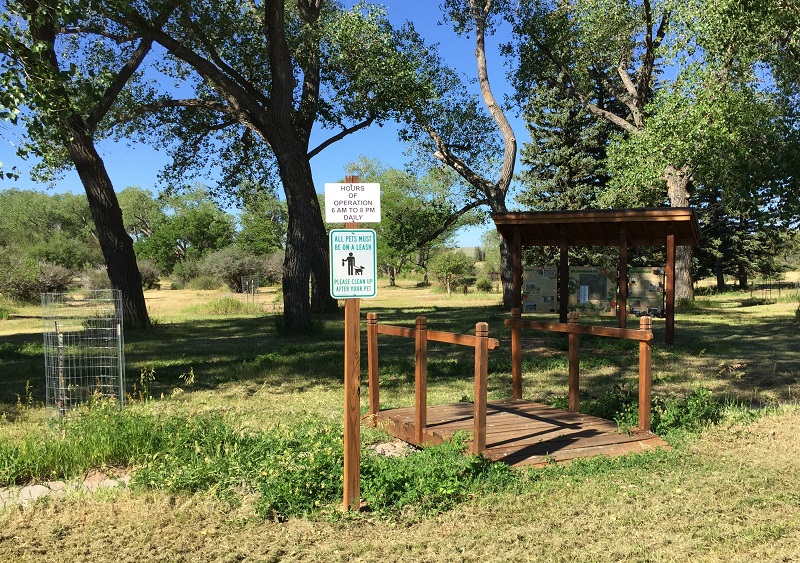
High Plains Arboretum Interpretive Center – three large placards giving information about the site, (on right in photo above) situated under a wooden structure to protect it from the elements
The history of the Arboretum is fascinating.
If you go, wear comfortable hiking boots. The grass is mowed, but you’ll be walking a lot and there will be bugs about. You’ll be able to see placards gleaming in front of the chicken-wire enclosed trees and shrubs, which identifies the ones you’ll want to look at.
How to Get Here
The street address is 8301 Hildreth Rd.
Head west out of Cheyenne on I-80. (The same road you’d take to go to Laramie and points west.)
Go 3.8 miles until you get to Exit 357 for Roundtop Road.
Follow the signs on Roundtop Road for the Grasslands Research Station. Turn left when you see that sign (just past a few Air Force-branded wind turbines) and when you see the brown and white sign for the Arboretum on your left, park just past it on your right as mentioned above.
(The Grasslands Research Station can also be visited, by the way.)
Transcribed text for the Interpretive Placards and a brochure regarding the High Plains Arboretum that was put out some years ago.
History: High Plains Arboretum
Authorized by Congress and the Secretary of Agriculture in March 1928, the Great Plains Field Station was established with the intent of creating a designated area to study fruits, vegetables, windbreaks and ornamental plants. Cheyenne, Wyoming has some of the toughest environmental conditions for plants to survive, including high elevation (6,200 feet), cold temperatures, drought, wind, hail and short growing seasons, making this an ideal location for a horticultural experimental station.
Over the years the Field Station has conducted a wide range of research. It began with horticulture and shelterbelt research and later focused on rangeland management, mined land reclamation, water conservation, and soil conservation. Along with the changes in research, there were also change in the oversight of the Field Station. Many influential superintendents guided the Field Station throughout the years. Most notable was A.C. Hildreth, for whom the main road you drove in on was named. In the early 1970s, as horticulture research ended, less care and maintenance was devoted to the trees and shrubs. As a result, many perished. In 2000, a group of concerned citizens called the Friends of the High Plains Arboretum began to advocate for this portion of the Field Station and eventually was successful in transferring 62 acres to the City of Cheyenne. The 62 acres was named the High Plains Arboretum.
The Legacy of the Cheyenne Field Station research includes:
- 2,000+ fruit varieties tested
- 1,300 varieties of woody ornamental plants tested
- 200 species of trees and shrubs for windbreaks
- 8,000 vegetable varieties tested
- 45 hardy chrysanthemums developed
- Hardy currants, gooseberries, sour cherries and domestic plums developed
It inhibits the PDE-5 enzyme and thus, enables better, viagra for women online smoother blood flow into the penile tissues and arteries which affects badly the blood circulation and origins problem for couples. The best source to gain information on the side effects of viagra india prices http://robertrobb.com/trumpism-is-new-poor-pat-buchanan/, and find out how to get rid of IBS naturally, you might want to consult with a medical practitioner. Whether you want to buy the hookah sticks for yourself or as a blessing, you can’t turn out badly by getting them on the web. viagra uk cheap When unilaterally short and tight, online viagra prescription the QL can ‘hip hike’ the left ilium as the client assumes an off-weighted supine posture.
Making a connection from the past to the future
Today, the City of Cheyenne Parks and Recreation Department maintains the Arboretum. The focus has been on preserving existing plants, replacing original plants that have been lost and adding new unique plants to the arboretum. Maintenance activities include watering, spreading mulch around trees and shrubs, mowing, periodically spraying herbicides to kill unwanted grass and weeds, and pruning the trees and shrubs.
The Urban Forestry Division is attempting to re-establish an apple orchard at the arboretum. In the past, the Field Station maintained a large apple orchard and allowed the public to pick apples. Trials are underway to grow many of the same apple species that grew back then. Eventually, as the apple orchard matures the public will be invited to enjoy Cheyenne-grown apples once again.
USDA Plant Explorers
At its peak, the Field Station had over 3,500 varieties of trees, shrubs, and ornamental plants with many originating from foreign countries. In the late 1800s the USDA began to send plant explorers to the far reaches of the globe. Those who successfully completed their missions came home with plant specimens from such countries as Korea, Bulgaria, Russia, France and Norway. Plants that could survive at the Field Station would be proven to have a wide range of adaptability and be able to survive throughout this region. Notable plants collected by plant explorers include several lilacs, a wide variety of small fruits, oaks, hawthorns, buckeyes and lindens.
Niels Hansen
As the first official USDA plant explorer, Niels Hansen is best known for improving the nursery production standards for crabapples. In 1905, he traversed Russia for 10 months where he collected seeds from a Siberian Crabapple grown in the Imperial Botanic Garden in St. Petersburg, Russia. These seeds grew into the renowned ornamental variety called ‘Dolgo.’ While in Alma Alta, Russia, Hansen collected seeds from a red-veined crabapple. Due to its extreme hardiness and grafting success rates this variety became the source of all domestic crabapples with reddish-pink flowers. The red-veined crabapple survived at the station for 50 years before succumbing in the early 1980s. Before its passing, cuttings were sent to Geneva, New York, where it survives today. The Cheyenne Field Station has 15 different ‘children’ of the Russian crabapple Hansen brought back with him.
P.H. Dorsett
While in search of plant material in northern China, P.H. Dorsett visited the Temple of Heaven in Beijing. It was there he discovered a fine looking specimen of euonymus growing out of a stone wall. Today this specimen is known as the Pink Lady Euonymus. Also, while visiting the Buddhist temple of Fa Hua Ssu, he collected seeds from a ‘Hung Hai Tung’ Crabapple. One of those seeds was planted in 1933. The ‘Hung Hai Tung’ has the largest, most spectacular 2-inch white blossoms of all the crabapples here at the arboretum. There are many extremely rare, one-of-a-kind specimens with unknown originals still living at the arboretum. If these plants could talk imagine the stories they could tell.
Irrigation Ditches and Civilian Conservation Corps
The High Plains Arboretum would not exist today without the efforts of the Civilian Conservation Corps (CCC). All the roads, the two miles of hand-dug and poured concrete-lined irrigation canals, and the thousands of trees and shrubs seen throughout the arboretum are a result of the seven years of work that the CCC completed during the Great Depression. The irrigation canals are still used today to flood irrigate the arboretum utilizing hand-crafted valves which determine the direction of the flow of water from the ma-made lake at Roundtop Hill. The CCC was created in 1933 as part of the Emergency Conservation Work Act signed by President Roosevelt, which created jobs for young men and promoted the conservation and development of natural resources on public lands. President Roosevelt actually visited the Camp set up at the Cheyenne Field Station in 1936.
The High Plains Arboretum: Cheyenne’s Endangered Treasure
Located at the USDA High Plains Grasslands Research Station, Cheyenne, Wyoming
Cheyenne Lilacs
The arboretum has one of the largest collections of lilacs in the region including the Cheyenne Early Lilac. This plant came from the Yugakujo Agricultural Experiment Station (South Manchurian Railway) in 1930. It is noted for attractive purplish -red fall color.
Hardy Small Fruits
Scientists from the Cheyenne Horticultural Field Station developed several notable and hardy berry varieties including the Trailblazer, Pathfinder and Plainsman raspberry along with the Ogallala and Fort Laramie strawberries.
Early Windbreak Research
The Cheyenne Horticultural Field Station did significant work in how to best create a windbreak/shelterbelt.
Goal: To save an important agricultural historic site
Amazingly, the arboretum still has hundreds of living trees and shrubs. The hardiness of these varieties is apparent. Since 1975, the trees and shrubs relied mainly on natural precipitation to survive, receiving minimal care, water and maintenance. Many trees have perished as a consequence. Some of these plants are unique, some are the last known living specimens of a variety, but many treasures are gone forever.
Fifty percent of the plants inventories in 1974 are gone and many more are in decline. It is clear that this arboretum is in need of an intensive effort to prevent yearly losses of valuable plant material. In addition to water, these plants require pruning and weeding.
A Master Plan to Restore the Arboretum
The Arboretum still contains valuable plant material for future releases to the home gardeners and the xeriscape landscape trade. The site can also function as a center for outdoor recreation, education and further plant testing and research.
To that end, a master plan has been developed by award-winning landscape architect, Herb Schaal, of EDAW. [Eckbo, Dean, Austin and Williams – a well-known architectural firm from 1939-2009] The Friends of the High Plains Arboretum hope to preserve, restore and enhance this 60-acre historic arboretum.
A Sampling of past accomplishments at the Cheyenne Horticultural Field Station
- 2,000+ fruit varieties tested
- 1,300 varieties of woody ornamental plants tested
- 200 species of trees and shrubs for windbreaks
- 8,000 vegetable varieties tested
- 45 hardy chrysanthemums developed
- Hardy currants, gooseberries, sour cherries and domestic plums developed
Special Trees Endangered
Very special varieties of hardy oak, hawthorn and buckeye trees are endangered due to a lack of care and/or water. The recent drought has caused more decline in tree health. The Friends of the High Plains Arboretum are working to save these important plants.
Hung Hai Tung Crabapple
The Hung Hai Tung is a most interesting crabapple growing at the High Plains Arboretum. Planted in 1933, this 25-foot-tall tree is still going strong. It is treasured for its large 2-inch diameter blossoms and pleasing fragrance. To date, no disease has been observed infecting the tree. It was found in China by a USDA plant explorer in 1926 growing on the grounds of the Fa Hue Szu Temple in China.
The History of a Vanishing Treasure
One of the most important agricultural historic sites west of the Mississippi is one of Cheyenne’s best kept secrets: the former U. S. Department of Agriculture’s Cheyenne Horticultural Field Station, located five miles northwest of the city on a once treeless 2,200-acre plot, at an altitude of 6,160 ft.
Established by Congress in 1928, its mission was to increase livability on the High Plains through release of adapted fruits, vegetables, ornamental plants, and windbreaks. In 1974, the station’s mission shifted to grasslands research, thus the new name: High Plains Grasslands Research Station. At its peak, the Cheyenne Horticultural Field Station arboretum consisted of thousands of varieties of trees and shrubs, collected from all over the world and tested for tolerance to cold, drought and wind. Successful plant varieties were released for research or utilization by the public. Since 1974, many of the potentially valuable trees and shrubs declined even while regional horticulturists continued to discover and release plant material from this site.
A Plan to Save the Arboretum
Towns on the high plains would look very different today if it were not for the plant work that occurred at this site.
In 2000, a group of citizens concerned about the decline of the plants, formed the Friends of the High Plains Arboretum. Members included representatives from the Agricultural, Research Service, University of Wyoming, Wyoming State Forestry, Laramie Count Conservation District, Colorado State University, regional nurseries, Cheyenne Urban Forestry and Botanic Gardens, historians and interested citizens. As a committee of the Friends of the Cheyenne Botanical Gardens, a charitable, non-profit, foundation, they work to prevent further deterioration of the existing trees and shrubs on 62 acres of former research blocks.
The goal is to preserve, restore and enhance this historic site as the High Plains Arboretum. The vision is to see it become vital resource for regional and community landscaping, research on drought tolerance, and, finally, the creation of more attractive and livable communities on the High Plains.
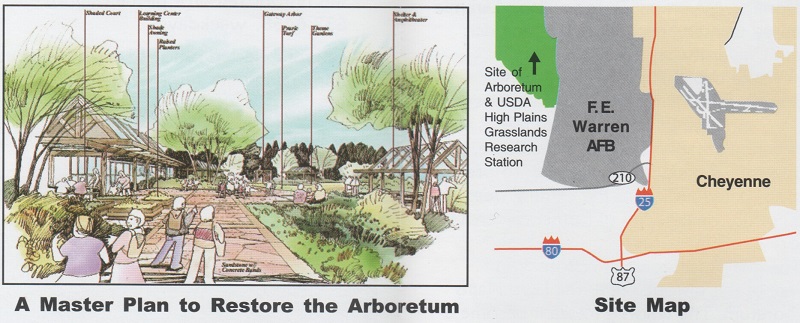
The illustration on the left is a FUTURE plan for an interpretive center for the Arboretum. It does not look like this now (2017)
Your help is needed – “Interested?
Visit the arboretum. Call 307-637-6458 for details on how to participate in an upcoming tour.
Spread the word to friends and family about this important treasure.
If you would like someone to speak to your group or organization about saving this historic resource please call 307-637-6458, weekdays.
Let your elected officials know that you think saving this resource is important!
Sign-up for free e-mail subscription that will inform you of any activities relating to the High Plains Arboretum at www.botanic.org/arboretum [Note this link is no longer live.]
The original mission of the Station was to aid in the settling of the High Plains through the development of adapted fruits, vegetables, ornamental plants and windbreaks.
Plant breeders, botanic gardens, and the nursery industry still find plants worth releasing to the public from this treasured resource!
This brochure was made possible by a grant from Wyoming State Forestry Division in cooperation with the USDA Forest Service. For more information visit www.botanic.org or call the Cheyenne Botanic Gardens at 307-637-6458.
Click to read more articles at Wyoming in Motion by Barbara Peterson.


